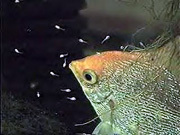
please update your bookmarks!
click banner for the new site and new sections
THIS PAGE IS ACTIVE BUT WILL NOT BE UPDATED, PLEASE GO TO THE MAIN SITE. YOU WILL BE AUTOMATICALLY TAKEN THERE IN 5 SECONDS
General Breeding Guidelines

please update your bookmarks!
click banner for the new site and new sections
THIS PAGE IS ACTIVE BUT WILL NOT BE UPDATED, PLEASE GO TO THE MAIN SITE.


General Guidelines For Breeding
Most aquarium fish are breed commercially for retail sale. Breeding your own fish is one of the most rewarding aspects of the hobby. Most of the fish available today were first breed by amateur hobbyist. The following is a very general guide for breeding. For a more detailed description of the way fish breed, continue past the general guidelines.

angelfish with fry
- Use only healthy fish with the color and traits you
wish to have in the fry.
- Prior to attempting to breed condition your fish with
good quality food, live if possible and keep the water at
its highest quality. Have ready a supply of food for the
fry usually Brine Shrimp nauplii.
- Make sure your water is soft to very soft and slightly
acid. Use deionized water like that made from the Aquarium
Pharmaceuticals Tap
water conditioner or if your tap water is good use
Tetras Black Water Extract.
- Have your breeding tank up and running and ready to
go.
- Move your breeding pair to the breeding tank. If all
is well your pair may spawn as early as the next morning,
but usually a few days will pass. Spawning sometimes can be
triggered by a partial water change. A successful mating
will be confirmed by the arrival of eggs, usually tiny
transparent spheres.
- As most fish cannot pass up a free meal it is now
time to remove the parents. The tank should also be
darkened if possible. It is very important to remove any
non-viable eggs as mold could destroy the entire clutch.
Viable eggs remain transparent throughout their
development. Incubation is usually very short between
twenty and thirty hours.
- Newly hatched fry will still have a yolk-sac and
once that is absorbed feeding should start with newly
hatched brine shrimp. Feed in small amounts and often. Dead
food should not be allowed to remain on the bottom. When
you see nice full bellies you know your ok.
- Once the fry have grown and are easily in the free
swimming stage it's time to move them to a bigger tank.
Keep up the water quality and good food and growth will be
very rapid. You now have a bunch of new fish that you don't
know what to do with! Congratulations.
These were the most generalized tactics and do not apply to all species they are posted here to be used as a guideline. I will cover specific breeding techniques in the individual descriptions.
methods of reproducing.
-
Fish which breed in this way either spawn in pairs or in
groups. Males and females release milt and eggs into the
water at the same time. These are mixed together and the
eggs are fertilized. The fertilized eggs float away in the
current or sink to the bottom, where they lie with the
substrate. There is no parental care given, so large
amounts of eggs are produced. The Characins and Cyprinids
are two of the species that lay their eggs this way.
-
Many fish species build nest in one form or another,
whether it is a simple pit dug into the gravel or the
elaborate bubble nest. No special breeding set-up is
needed, when ready to spawn the fish construct a nest by
blowing bubbles, often using vegetation to anchor the nest.
The male will keep the nest intact and keep a close eye on
the eggs. The female should be removed after spawning. Care
is needed to raise the fry and the tank should have a glass
cover to help keep the nest moist and warm. The Gouramis,
Anabantids and some catfish are the most common of this
type of spawners.
-
In this case, the eggs are either laid on a flat surface, like a stone or plant leaf or even individually placed among fine leaved plants like Java moss. The parents usually form pairs and guard the eggs and fry from all danger. The Cichlids are the best known species for this. Some Catfish and Rainbowfish are also Egg depositors. The set-up for these fish will vary with the species, but usually you have to provide a flat stone, broadleaf plant, cave or a broken flower pot. Sometimes you can remove the item that the eggs have been laid on to a separate hatching tank.
-
The females usually lay their eggs on a flat surface where they are then fertilized by the male. After fertilization the female picks up the eggs and incubates them in her mouth. Even after hatching the fry will return to the safety of their mothers mouth if danger is near. Brood numbers are usually small, since by the time the fry are released they are well formed and loses are minimal. The best known Mouthbreeders are the African lake Cichlids.
-
The annual Killifish are known for this method of reproduction. As the pools where they live dry out, the fish spawn. pressing their eggs into the substrate. The pools dry out completely and the adults die, but the eggs remain in the dried mud. When the rains return and the pool refills the eggs hatch and the cycle is repeated. Killifish eggs can stay viable for many years in the dried out mud.
Livebearers
-
The livebearers do not lay eggs at all, they are fertilized internally and carried to term inside the mothers body. The broods are small and the fry are well developed when born.The Guppy swordtail and Platy are the best known members of this group.

Navagation panel.
|
|